
Chapter 9: Land and Water Use
When humans use natural resources, they alter natural systems.
Humans can mitigate their impact on land and water resources through sustainable use.
Key Terms
Tragedy of the commons: A shared resource that no one owns and everyone can use is overexploited and eventually unavailable to all.
Clear-cutting: An economically viable way of cutting down all the trees in an area of a forest for human use.
Mechanization: Using mechanical means like tractors and farm equipment to harvest crops.
Fertilization: Using man-made, chemical fertilizers on crops to help them grow better.
Tilling: Turning the land over so you can plant crops, but this can lead to erosion of the soil from both water and wind.
Slash-and-burn farming: This is an agricultural method for taking wild land such as a forest, and clearing it to grow crops. Usually this method involves slashing (cutting down) and burning the plants that were found there and planting a crop.
Drip irrigation: Using hoses that slowly drip water onto the roots of plants. Pro: conserves water. Con: expensive.
Flood irrigation: Flooding an entire crop with water. Pros: cheap and quick. Cons: uses large quantities of water and water is lost to evaporation.
Furrow irrigation: Building rows between crops and flooding those rows with water. Pros: cheap and quick. Cons: uses large quantities of water and water is lost to evaporation.
Spray irrigation: Using sprinkler-type devices to water crops. Pro: less water lost to evaporation. Con: expensive.
Waterlogging: When soil gets so flooded with water, and the water then evaporates but the salt is left behind. After many years of this, the land is so salty that most plants can’t grow.
Salinization: Salt in the soil that limits plant growth.
Aquifers: A layer of rock that is filled with water.
Pesticides: A generic term to describe any herbicide, fungicide, rodenticide, or insecticide.
Herbicides: A chemical that kills unwanted plants.
Fungicides: A chemical that kills unwanted fungi.
Rodenticides: A chemical that kills unwanted rodents such as mice and rats.
Insecticides: A chemical that kills unwanted insects.
Concentrated animal feeding operations: Large feeding operations with many animals in a small area. Pro: increased profits. Cons: disease can spread so large amounts of antibiotics are used and manure and urine can run off into local waterways.
Free-range grazing: Allowing animals to roam free and eat on grassy pastures.
Overgrazing: When too many animals are allowed to eat in an area and the grass/plants can’t recover. This often leads to desertification.
Desertification: When an area is so overgrazed it can’t recover and the area can become a desert.
Overfishing: Taking too many fish at one time by commercial fishing and not allowing the breeding stock to reproduce and replenish.
Surface mining: A type of mining where minerals are found near to the surface with only soil and small amounts of rock above it so it is inexpensive and relatively easy to obtain.
Overburden: The rock and soil found above a mine that must be removed to get to the mineral resource.
Slag and tailings: The waste from mining that must be dealt with and can be an environmental problem if it is not.
Subsurface mining: Digging deep into the Earth to get to the mineral resource. Pro: can get to a resource that is abundant deep within the Earth. Con: expensive and sometimes dangerous.
Urbanization: People moving from rural areas and into cities looking for jobs or other opportunities.
Saltwater intrusion: Occurs when too many people living in cities close to the coastline draw on an aquifer for fresh water. The freshwater is removed and the salt water can move into the aquifer, destroying the aquifer.
Impervious surfaces: Surfaces like concrete or asphalt that don’t allow for water to infiltrate into the ground.
Permeable surfaces: Surfaces that do allow water to seep into the ground and replenish aquifers or water plants.
Urban sprawl: Term used to describe cities as they expand more and more into the surrounding ecosystems/habitats.
Ecological footprint: The area of land (measured in hectares) that a person or society uses due to the pressures it puts on the environment.
Urban runoff: Occurs when cities are so covered with concrete, asphalt, buildings, and so on, that water can’t infiltrate into the land and runs off instead.
Infiltration: The ability of water to move through the soil and perhaps into an aquifer.
Integrated pest management: The method of killing pests without using as much pesticide; for example, using predator bugs and rotating crops.
Biocontrol: A method of integrated pest management that uses predator bugs to control pest species.
Intercropping: A method of integrated pest management where rows of crops that repel pests are planted next to the row of crops the farmer wants to sell.
Crop rotation: A method of rotating crops to different fields so the soil has a chance to recover and minerals are not depleted.
Contour plowing: Planting crops with the contour of the land to prevent erosion.
Windbreaks: Planting trees or shrubs next to crops to prevent wind erosion.
Perennial crops: Planting crops that don’t need to be replanted each year but can be harvested multiple times throughout the year.
Terracing: Creating flat terraces on mountainsides to plant crops and prevent erosion.
No-till agriculture: Planting crops without tilling, or churning the soil, before you plant.
Strip cropping: Planting crops in strips with one strip having a crop with deep, extensive roots and one that doesn’t. The crop with roots will hold in the soil and prevent erosion that the other crop doesn’t do.
Rotational grazing: Moving animals around to various pastures to allow the grass to recover from grazing.
Aquaculture: Farm raising fish, shellfish, or aquatic plants to sell.
Pros: inexpensive and uses less water and energy.
Cons: can cause disease and, if the farmed animal or plant escapes its enclosure, it could reproduce or outcompete with native species.
Reforestation: Planting new trees after harvesting the adult ones.
Prescribed burns: Intentionally starting a fire in a forest to allow the brush and dead trees to be burned and the larger trees to not be destroyed. This prevents a forest from having a larger “crown” fire that can destroy the entire forest.
The Tragedy of the Commons
The tragedy of the commons holds that individuals tend to overexploit shared resources until the resource becomes unavailable to all.
Garrett Hardin originally explained this concept using an analogy of ranchers taking their animals to a common field. Hardin said that when there are just a few animals feeding off the common area there is no problem.
However, when many ranchers come and add more and more animals, and there are no rules as to how many or how long the animals can graze, with the rancher caring only about their own profits, soon the area will be decimated and unusable to anyone.
Clear-Cutting
Forests are an important resource, both for the environment and for human use.
The trees in forests are huge carbon sinks, meaning they are able to absorb large amounts of carbon dioxide from our atmosphere (carbon dioxide is a leading contributor to climate change that we will discuss in a future chapter).
When we cut and burn the trees to make room for housing or agriculture, we release the carbon stored in the trees into the environment, leading to increased carbon dioxide levels and climate change.
Forests also remove pollutants both from the atmosphere and from the water and soil.
Clear-cutting is a method of harvesting trees in the forest for human use
. These uses can be for building materials, fuel for fires, paper, and so on.
A cheap and easy method of harvesting these trees is to cut them all down at one time in large areas.
This method is called clear-cutting (Figure 9.1).
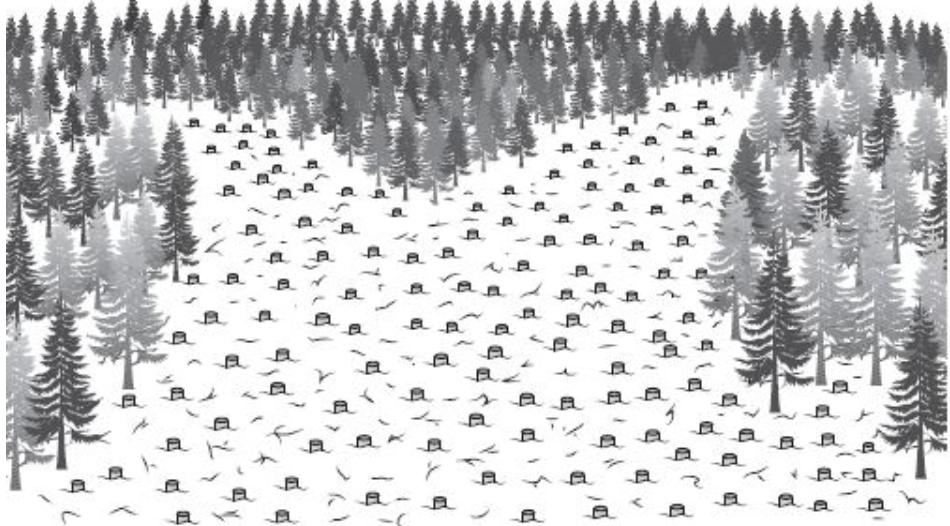
Clear-cutting has many environmental consequences even though from an economic standpoint it is a benefit since it is cheaper than other methods.
Since trees have roots that hold the soil, when we clear cut large areas of land we expose this soil, leaving it vulnerable to erosion and/or flooding.
This soil may end up in a river, lake, or stream leading to problems there.
Trees also provide shade, so when we cut them down, the temperature in these areas is increased because the sun hits the ground directly.
The Green Revolution
In Mexico and India in the 1940s and beyond, the Green Revolution brought new disease-resistance varieties of plants like wheat and rice, new technologies for mechanized harvesting, and new chemical fertilizers, irrigation practices, and pesticides.
The Green Revolution has allowed us to feed more people, to make larger profits, to create tastier and more nutritious food, and to use less pesticide and water, but there are some consequences to these practices.
Increased mechanization has led to a greater use of fossil fuels, leading to climate change.
Genetically modified organisms (GMOs) are organisms (plants, animals, and micro-organisms) that have had their DNA modified in some way through genetic engineering.
GMOs are often developed to increase food’s flavor or to make the plant resistant to disease and drought. Some people are concerned that GMOs have increased allergic reactions in some individuals.
Impact of Agricultural Practices
Providing food for a growing human population is important and we are doing this in better and better ways.
However, there are environmental impacts of many of the practices we use.
For example, tilling the soil is how farmers dig, stir, and turn the soil over so they can plant new crops.
This helps to aerate the soil and allows for the seedlings to get established.
However, when we till the soil it leaves the soil vulnerable to erosion, which we discussed as an environmental concern in a prior chapter.
Also, many farmers use a technique called slash-and-burn farming, where they take wild or forested land and convert this to farmland.
This devastates habitats and species, causes deforestation, and can lead to climate change.
Fertilizers and pesticides also have large environmental problems. Fertilizers can run off the land and end up in the water causing a problem called eutrophication that we will discuss in a future chapter.
Pesticides can contaminate the soil and water and be toxic to organisms that they were not intended to harm such as birds, fish, “good” insects, and plants.
Irrigation Methods
Drip irrigation—This method saves water because only about 5 percent of the water is lost to evaporation, but it is pretty expensive.
You might have seen this at your house or in businesses.
This method uses hoses with small holes where water seeps out slowly, getting the water down to the roots (Figure 9.2).
Using this on a large scale for mass food production is costly, but it helps prevent erosion and nutrient runoff and discourages weeds since the water is targeted.
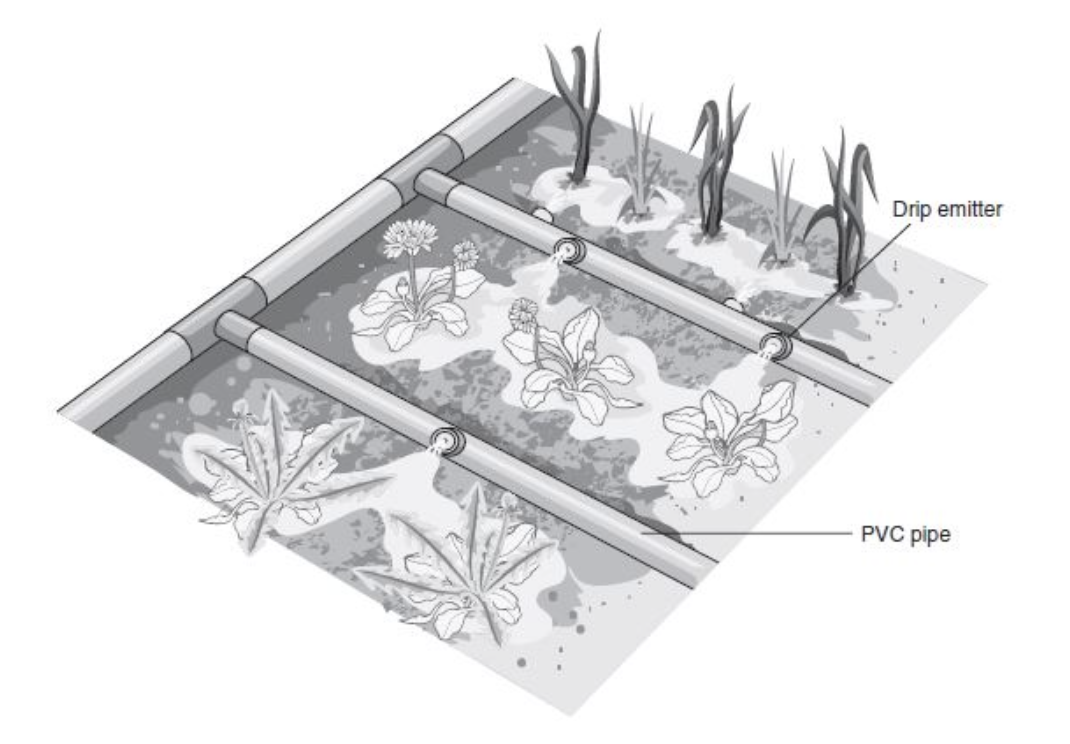
Flood irrigation—In flood irrigation the farmer floods an entire field with water (Figure 9.3).
The benefits of this include the ability to produce more food (therefore increasing profits for the farmer) and incur less loss of crops from drought.
However, the cons of this are that a lot of water is lost to evaporation and it can increase salinization of the soil.
Soil salinization results when salt in the water is left on crops after the water evaporates. While water can evaporate, salt will not. After time, so much salt can be left on the soil that plants can’t grow.
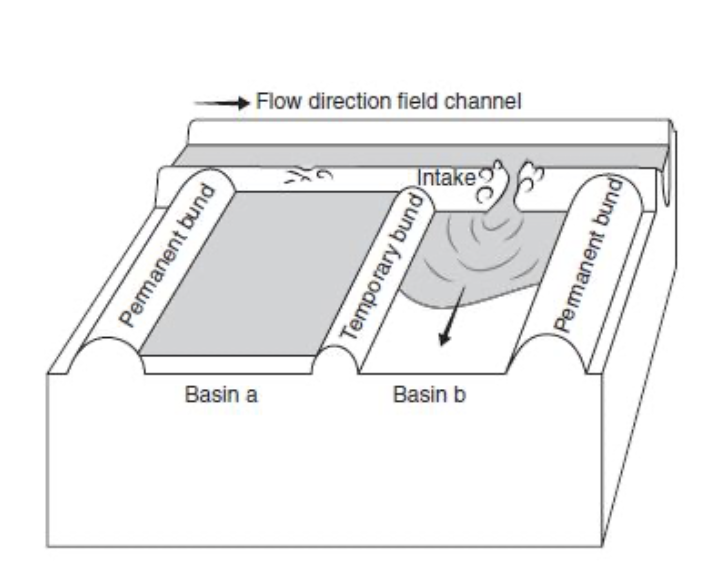
Furrow irrigation—This method is similar to flood irrigation except that trenches are dug between rows of crops and that area is flooded with water.
This allows the farmer to flow water down these trenches and the water is absorbed by the roots of the plants (Figure 9.4).
The advantages and disadvantages are similar to flood irrigation with about 35 percent being lost to evaporation.
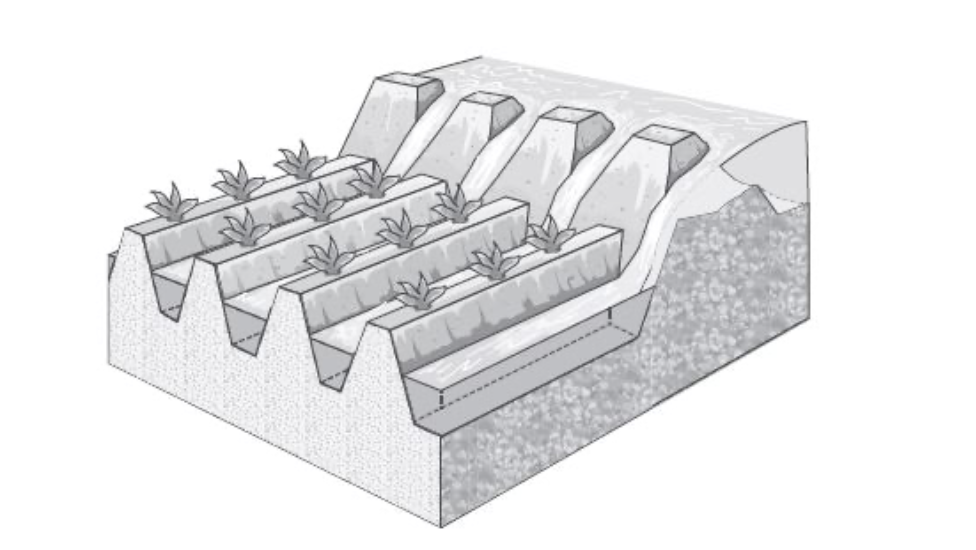
Spray irrigation—This method is the one you are probably most familiar with. You see this on lawns all the time with sprinklers, but on a large scale this is done on crops (Figure 9.5). This method loses less water than either flood or furrow but is more expensive.
Waterlogging happens when so much water is left on the soil it is saturated.
The water affects plants by lowering the levels of oxygen to the roots and impacting the germination of seeds and young plants.
Aquifers are underground layers of water that can be tapped for irrigation and other uses.
However, if too many wells are drilled, the water can be severely depleted depending on the type of aquifer and the demand for the water.
In fact, the Ogallala Aquifer in the middle of the United States, where much of our food is grown, is being severely depleted due to massive overuse in the past century.
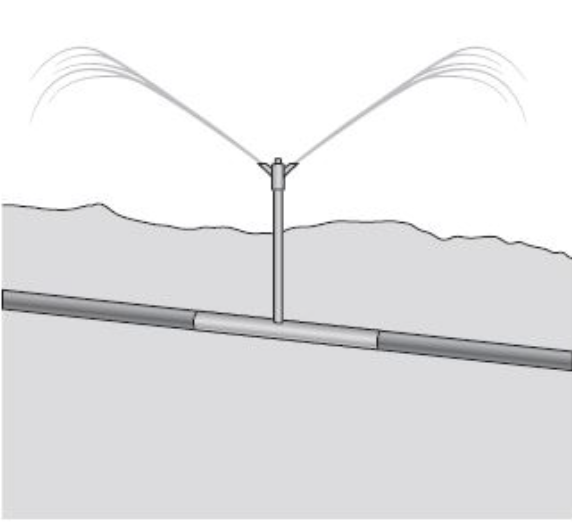
Pest Control Methods
One problem with many of these pesticides is that the organism that the pesticide is designed to kill builds up resistance over time.
Pesticides are designed to prevent crop damage and increase crop profits, but if pesticide resistance becomes a problem, the pesticide will no longer work (or will not work as well).
The farmer/homeowner will have to either use more pesticide or stronger doses, or switch to a new type, and this can impact both the profits and the environment.
The pesticide treadmill is a term used for when a farmer continues to add more and more pesticides or switches from one to another as they become ineffective.
One method to help stop this is by genetically engineering crops so the pests don’t or can’t harm them.
A pro is that there is less need for pesticides, which is good for the environment since pesticides can often harm other organisms that they weren’t designed to harm.
Other pros are increased profits for farmers and helping keep the cost of food affordable.
However, on the negative side is the loss of diversity in the crop.
Meat Production Methods
Concentrated animal feeding operations (CAFOs), also known as feedlots, are defined as a feeding operation involving more than 1,000 animal units (defined as 1,000 pounds of animal weight) held for more than 45 days, or any size feeding operation that discharges manure or wastewater into a natural or man-made ditch, stream, or other waterway.
The pros of CAFOs are profits because you can get a lot of animals ready for slaughter very quickly and cheaply, which means increased profits for ranchers and lower priced food for consumers.
The cons of CAFOs are many.
Animals are usually packed into small enclosures with thousands of animals crowded into one CAFO, they are often fed a man-made feed rather than grass, and many times the animals are given large doses of antibiotics to prevent disease.
Because of the number of animals crowded together, large amounts of waste are generated, which can pollute local rivers, streams, lakes, and land areas.
Free-range grazing is what it sounds like—animals are allowed to roam free and graze as needed on open land.
The pros of this method are animals are free to roam, fewer or no antibiotics are given, and because there are fewer animals, the manure is less concentrated, leading to the waste being a beneficial fertilizer and not a problem.
However, this is a more expensive choice for ranchers and large amounts of land are needed.
Farmers must be careful to not overgraze the land. Overgrazing happens when farmers/ranchers put too many animals on an area and the area begins to lose all plants.
Any area that has low rainfall in general and then loses all plants is said to have undergone desertification.
Overgrazing can also lead to soil erosion; the plants’ roots hold the soil in place and when the plants are gone the soil can easily be eroded by wind or water.
Eating less meat has some big environmental advantages. First, it takes almost 20 times less land to get the same number of calories from growing plants.
Animals also produce a lot of methane and carbon dioxide, two things we will discuss in detail in the chapter relating to climate change.
If we don’t eat as much meat, we lower the use of antibiotics and growth hormone, use less water, and prevent erosion of soil caused by overgrazing.
Impact of Overfishing
Overfishing is commercial fishing in which large quantities of fish are caught faster than the species can breed and replace itself.
Since many people depend on fish for their food supply, overfishing can be very dangerous and can impact aquatic ecosystems by disrupting the food chain.
When too many fish are taken out of the ocean, it can destroy food webs, lead to a loss of marine life, and can have a large socioeconomic impact on humans who rely on fishing for their livelihood and food needs.
Impact of Mining
There are many minerals found on Earth’s surface and underground that we need for human purposes
For example: coal. When the mineral resource is found on the surface of the Earth and we extract this mineral resource, it is called surface mining (Figure 9.6).
When the resource is found deep underground, it is called subsurface mining, which is more expensive (Figure 9.7).
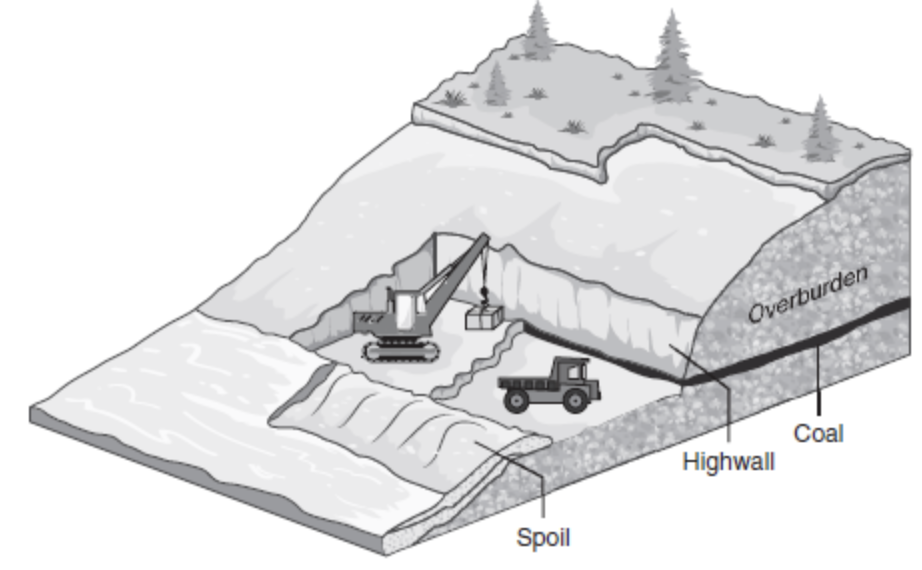
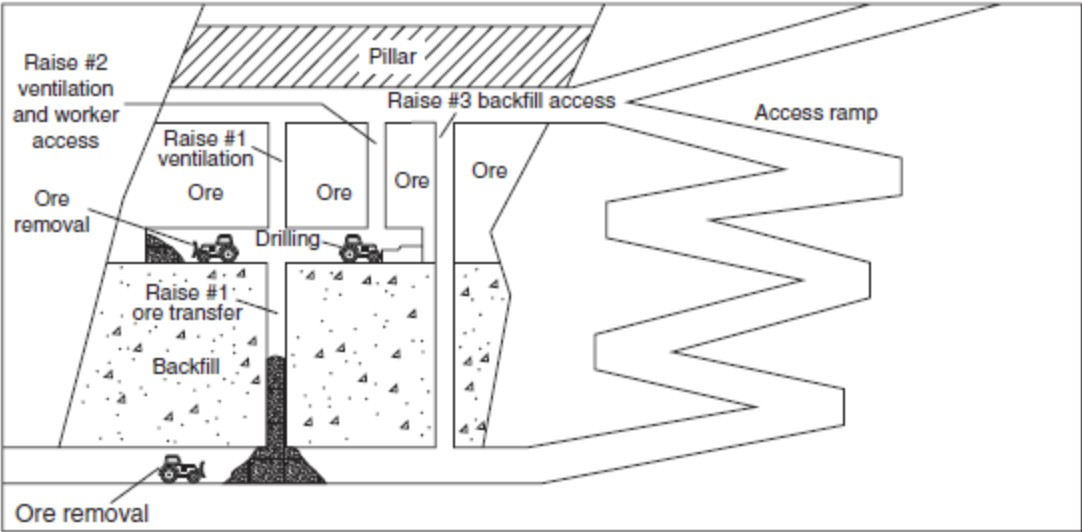
There are many methods of surface mining, such as strip mining, open-pit mining, and mountaintop removal.
Each of these has its own set of environmental impacts. In order to get to these resources, miners must first remove the soil, plants, and rock known as overburden.
After mining, the wastes from mining, called slag and tailings, are left behind to be dealt with.
Mining removes plant life, opens the soil up to erosion and runoff, harms habitats, can contaminate aquifers, releases methane from the soil, and causes fine particles of dust to be released.
Impact of Urbanization
Urbanization occurs as people move from rural areas and into cities, usually in search of job opportunities.
Urbanization has many benefits such as increased job opportunities and access to basic needs like clean water and electricity.
However, as more people live together there are some costs to the environment.
For example, as we pave land to build roads, houses, and parking lots, water can’t seep into the soil and refill aquifers.
This can also cause increased runoff and flooding since the water runs off the pavement and doesn’t infiltrate into the soil.
In addition, as more people move to cities and gain access to electricity, we mine and burn more coal, oil, or natural gas.
This can lead to an increase of carbon dioxide or land damaged from mining.
Saltwater intrusion: If there are too many people putting a demand on fresh water, and the city is located near the ocean, we can overdraw the aquifer allowing the saltwater to move into the freshwater aquifer. This can destroy aquifers.
Urban sprawl: The expansion of urban areas into rural areas. It can cause water and air pollution and destroy habitats.
Ecological Footprints
Each person or society has an ecological footprint, and it is measured by the amount of land (in hectares) needed by the person or society to support their way of life.
To calculate the ecological footprint, you would take the person’s or society’s demands such as timber, electricity, food, gas, and so on, and assign a number to that need.
For example, a person in the United States, who lives in a home that is heated by oil, drives a car using gas, has clothing and food needs, and produces carbon emissions would have a much greater ecological footprint than a person living in a poor country possibly living in a hut with no electricity, no car, and growing their own food or living off the land.
Introduction to Sustainability
Everyone needs access to a healthy environment, clean air and water, and natural resources. Sustainability is the access to each of these for human use without depleting them.
There are many things we can do as humans to help, such as limiting our use of resources, reduce/reuse/recycle, green building, and employing sustainable agriculture.
As long as we stick to a sustainable yield, or not taking more than can be regrown, replenished, or reused, we can live on this planet for many years to come.
Methods to Reduce Urban Runoff
As we discussed earlier in this chapter, as we pave surfaces, build buildings, and put in roads, we stop allowing water to infiltrate into the soil and we increase the amount of water that runs off.
There are many ways to reduce this runoff.
For example, if a company wanted to build a parking lot, they could add areas throughout the parking lot with plants and trees and soil.
This way, although there are less actual parking spaces, when it rains the water can soak into the natural areas and the runoff will not be that bad.
You can also plant trees around the parking lot that will absorb water and reduce runoff.
Impervious surfaces like concrete or asphalt don’t allow for water to infiltrate into the ground.
Using pavers instead of asphalt or concrete in a parking lot will allow water to seep into the ground between the pavers and not run off.
These types of permeable surfaces, shown in Figure 9.8, allow water to seep into the ground and replenish aquifers or water plants.
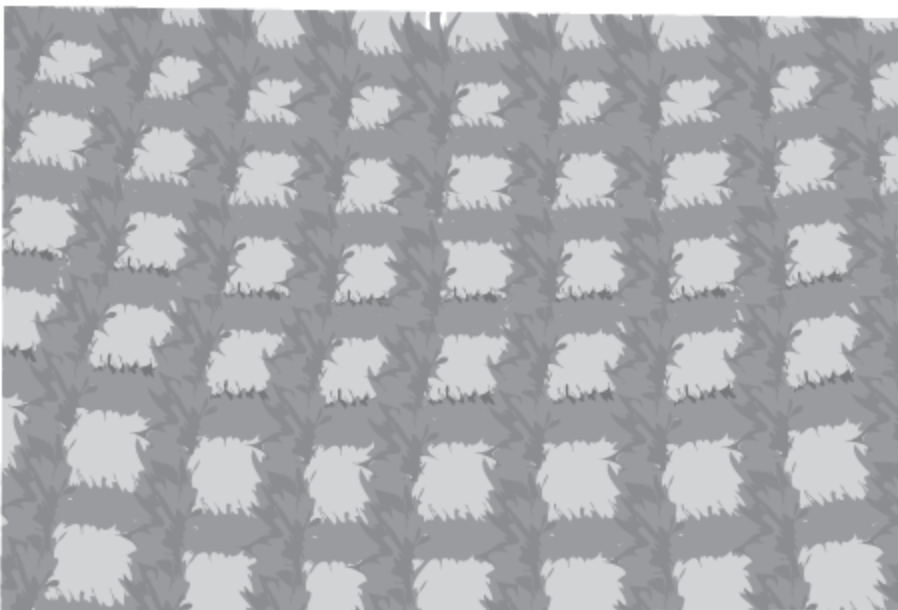
Integrated Pest Management
Pests are a huge problem for humans for many reasons. They eat our crops, make us sick, destroy our building structures, and can be nuisances in our lives.
We often try to kill these pests using pesticides, herbicides, and fungicides. But, as mentioned earlier in this chapter, these can have devastating effects on the environment.
Humans can mitigate this problem a little by implementing integrated pest management (IPM), which is a method of killing or preventing the bugs without using as much pesticide. So, we might step on the cockroach rather than grabbing the can of insecticide.
But, on a larger scale for crops, we need other methods. These can include biological methods like predator bugs that a farmer buys to eat the pests (biocontrol), or rotating crops to plant ones that naturally are resistant to the pest.
We can also use intercropping, a method of planting rows of crops that are different; one row is a crop that repels the insect while another row is the crop the farmer wants to harvest.
These methods are all better for the environment than the chemical pesticides that have historically been used. The problem with IPM for farmers is the expense it incurs.
Sustainable Agriculture
Our agricultural practices have environmental impacts.
If we overgraze, we cause soil to erode, and we reduce soil fertility and its ability to sustain plant life.
Many farmers and ranchers are looking at ways to reduce this and still produce food for humans.
Ranchers can make sure to not overgraze by rotating their animals to different pastures, allowing the grass to regrow and recover.
This is called rotational grazing. We can prevent soil from losing valuable nutrients by rotating the places we plant these crops or by adding manure to increase nutrient values and limestone to balance acidity to protect soil health.
Contour plowing: Planting crops along the contours of the land as shown in Figure 9.9.
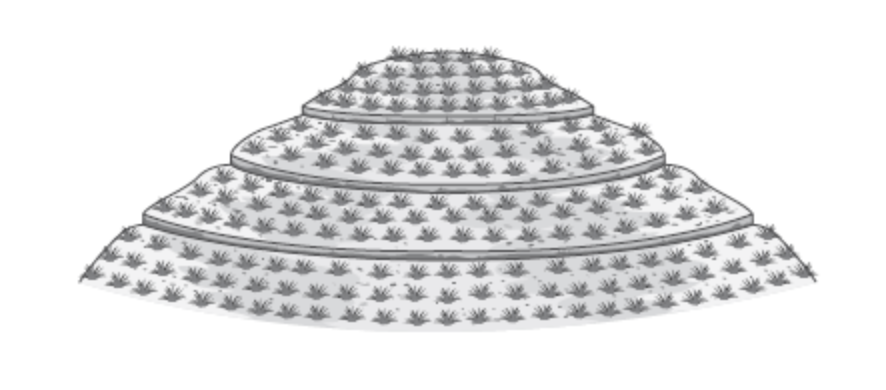
Windbreaks—Planting trees or shrubs to limit erosion as shown in Figure 9.10.
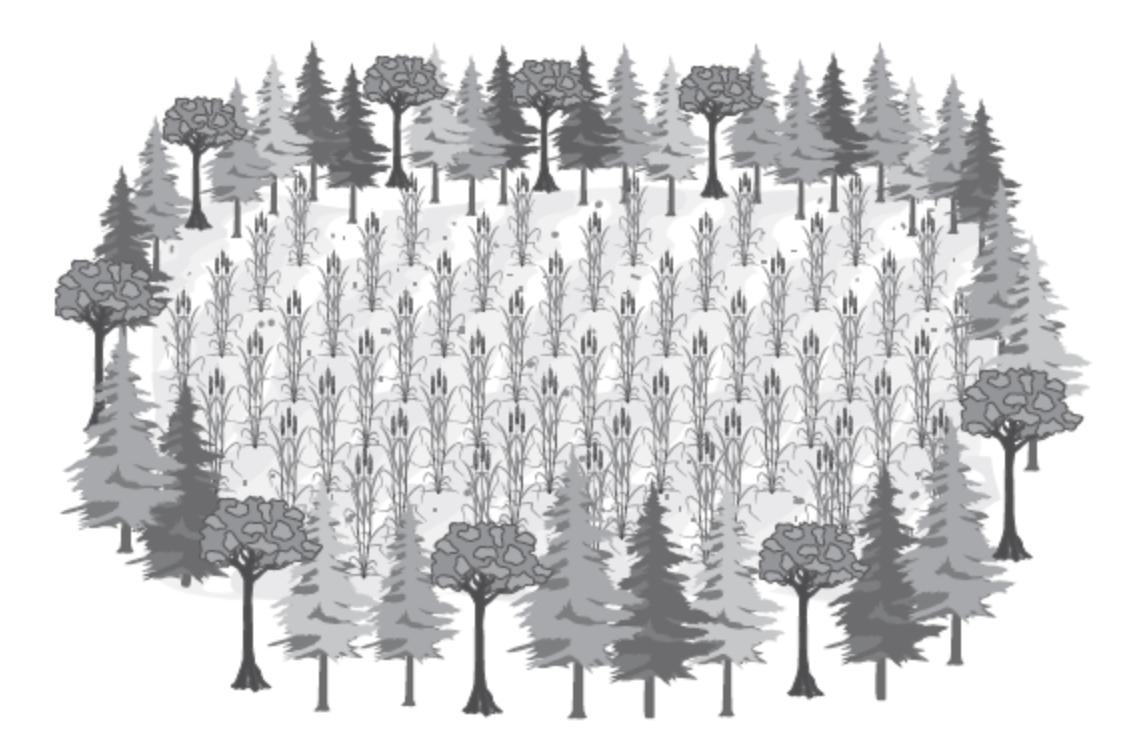
Perennial crops—Planting crops that don’t need to be replanted each year and can be harvested multiple times during the year. After harvest, they automatically grow back. By eliminating replanting each year, perennial cropping can reduce soil erosion.
Terracing—Similar to contour plowing but when an area is very hilly or mountainous. The farmer will make step-like rows and plant the crops on these rows. This helps to reduce soil erosion. Figure 9.11 shows how the steep mountain was made into steps and crops were planted on the top of each step.
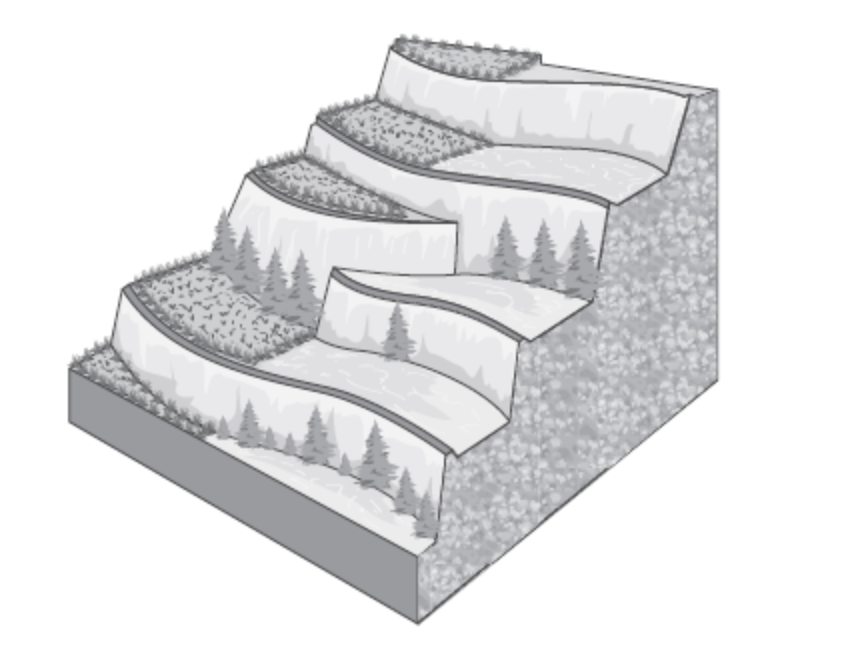
No-till agriculture—This method is what it sounds like, planting crops but without tilling the soil before planting. This reduces soil erosion because when we turn the soil over (tilling), it is vulnerable to wind and water erosion.
Strip cropping—Planting a strip of one crop, then a strip of another, alternating throughout the field. This prevents soil erosion because one row might have crops with deep roots, while the next one doesn’t. The deep roots will hold in the soil for the plants that don’t have deep roots. You can see an example of this in Figure 9.12.
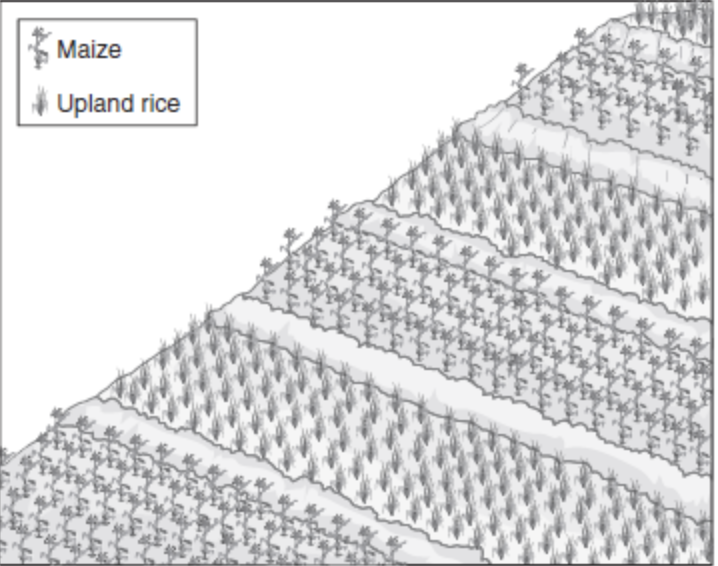
Aquaculture
Aquaculture is a method of farm raising fish, shellfish, or aquatic plants. A farmer can build large ponds and stock these ponds with large numbers of animals or plants, or use a natural river, lake, or ocean to do this with nets and holding pens.
The benefits of aquaculture are that it doesn’t deplete our natural supplies of these organisms, it feeds a large number of people, it uses less water, it increases profits, and it uses very little fuel.
However, there are environmental problems
For example: large numbers of fish can produce huge quantities of waste (fish poop, excess fish food, etc.), which can pollute the river, lake, or ocean.
These fish might escape their enclosures and if they are not a natural species can outcompete natural species or breed with wild species. In addition, when we put large numbers of animals together in one area, disease can spread very quickly and these diseases might spread to wild populations.
Sustainable Forestry
Humans have a large need for resources made from forests. These include building materials, paper, medicine, and food.
However, there are more sustainable ways to harvest forests so that humans can use them for many years and we don’t harm the environment and the animal habitat as much.
For example, we can replant trees after cutting them down (reforestation), we can do prescribed burns to clear out the brush, which can prevent larger “crown” fires.
We can make sure to purchase wood that is grown on a tree farm rather than a natural forest. We can also reduce, reuse, and recycle wood products for future use.
Using IPM to prevent trees from getting pests like fungus or bugs can also help sustain a forest for many years.
Chapter 9: Land and Water Use
When humans use natural resources, they alter natural systems.
Humans can mitigate their impact on land and water resources through sustainable use.
Key Terms
Tragedy of the commons: A shared resource that no one owns and everyone can use is overexploited and eventually unavailable to all.
Clear-cutting: An economically viable way of cutting down all the trees in an area of a forest for human use.
Mechanization: Using mechanical means like tractors and farm equipment to harvest crops.
Fertilization: Using man-made, chemical fertilizers on crops to help them grow better.
Tilling: Turning the land over so you can plant crops, but this can lead to erosion of the soil from both water and wind.
Slash-and-burn farming: This is an agricultural method for taking wild land such as a forest, and clearing it to grow crops. Usually this method involves slashing (cutting down) and burning the plants that were found there and planting a crop.
Drip irrigation: Using hoses that slowly drip water onto the roots of plants. Pro: conserves water. Con: expensive.
Flood irrigation: Flooding an entire crop with water. Pros: cheap and quick. Cons: uses large quantities of water and water is lost to evaporation.
Furrow irrigation: Building rows between crops and flooding those rows with water. Pros: cheap and quick. Cons: uses large quantities of water and water is lost to evaporation.
Spray irrigation: Using sprinkler-type devices to water crops. Pro: less water lost to evaporation. Con: expensive.
Waterlogging: When soil gets so flooded with water, and the water then evaporates but the salt is left behind. After many years of this, the land is so salty that most plants can’t grow.
Salinization: Salt in the soil that limits plant growth.
Aquifers: A layer of rock that is filled with water.
Pesticides: A generic term to describe any herbicide, fungicide, rodenticide, or insecticide.
Herbicides: A chemical that kills unwanted plants.
Fungicides: A chemical that kills unwanted fungi.
Rodenticides: A chemical that kills unwanted rodents such as mice and rats.
Insecticides: A chemical that kills unwanted insects.
Concentrated animal feeding operations: Large feeding operations with many animals in a small area. Pro: increased profits. Cons: disease can spread so large amounts of antibiotics are used and manure and urine can run off into local waterways.
Free-range grazing: Allowing animals to roam free and eat on grassy pastures.
Overgrazing: When too many animals are allowed to eat in an area and the grass/plants can’t recover. This often leads to desertification.
Desertification: When an area is so overgrazed it can’t recover and the area can become a desert.
Overfishing: Taking too many fish at one time by commercial fishing and not allowing the breeding stock to reproduce and replenish.
Surface mining: A type of mining where minerals are found near to the surface with only soil and small amounts of rock above it so it is inexpensive and relatively easy to obtain.
Overburden: The rock and soil found above a mine that must be removed to get to the mineral resource.
Slag and tailings: The waste from mining that must be dealt with and can be an environmental problem if it is not.
Subsurface mining: Digging deep into the Earth to get to the mineral resource. Pro: can get to a resource that is abundant deep within the Earth. Con: expensive and sometimes dangerous.
Urbanization: People moving from rural areas and into cities looking for jobs or other opportunities.
Saltwater intrusion: Occurs when too many people living in cities close to the coastline draw on an aquifer for fresh water. The freshwater is removed and the salt water can move into the aquifer, destroying the aquifer.
Impervious surfaces: Surfaces like concrete or asphalt that don’t allow for water to infiltrate into the ground.
Permeable surfaces: Surfaces that do allow water to seep into the ground and replenish aquifers or water plants.
Urban sprawl: Term used to describe cities as they expand more and more into the surrounding ecosystems/habitats.
Ecological footprint: The area of land (measured in hectares) that a person or society uses due to the pressures it puts on the environment.
Urban runoff: Occurs when cities are so covered with concrete, asphalt, buildings, and so on, that water can’t infiltrate into the land and runs off instead.
Infiltration: The ability of water to move through the soil and perhaps into an aquifer.
Integrated pest management: The method of killing pests without using as much pesticide; for example, using predator bugs and rotating crops.
Biocontrol: A method of integrated pest management that uses predator bugs to control pest species.
Intercropping: A method of integrated pest management where rows of crops that repel pests are planted next to the row of crops the farmer wants to sell.
Crop rotation: A method of rotating crops to different fields so the soil has a chance to recover and minerals are not depleted.
Contour plowing: Planting crops with the contour of the land to prevent erosion.
Windbreaks: Planting trees or shrubs next to crops to prevent wind erosion.
Perennial crops: Planting crops that don’t need to be replanted each year but can be harvested multiple times throughout the year.
Terracing: Creating flat terraces on mountainsides to plant crops and prevent erosion.
No-till agriculture: Planting crops without tilling, or churning the soil, before you plant.
Strip cropping: Planting crops in strips with one strip having a crop with deep, extensive roots and one that doesn’t. The crop with roots will hold in the soil and prevent erosion that the other crop doesn’t do.
Rotational grazing: Moving animals around to various pastures to allow the grass to recover from grazing.
Aquaculture: Farm raising fish, shellfish, or aquatic plants to sell.
Pros: inexpensive and uses less water and energy.
Cons: can cause disease and, if the farmed animal or plant escapes its enclosure, it could reproduce or outcompete with native species.
Reforestation: Planting new trees after harvesting the adult ones.
Prescribed burns: Intentionally starting a fire in a forest to allow the brush and dead trees to be burned and the larger trees to not be destroyed. This prevents a forest from having a larger “crown” fire that can destroy the entire forest.
The Tragedy of the Commons
The tragedy of the commons holds that individuals tend to overexploit shared resources until the resource becomes unavailable to all.
Garrett Hardin originally explained this concept using an analogy of ranchers taking their animals to a common field. Hardin said that when there are just a few animals feeding off the common area there is no problem.
However, when many ranchers come and add more and more animals, and there are no rules as to how many or how long the animals can graze, with the rancher caring only about their own profits, soon the area will be decimated and unusable to anyone.
Clear-Cutting
Forests are an important resource, both for the environment and for human use.
The trees in forests are huge carbon sinks, meaning they are able to absorb large amounts of carbon dioxide from our atmosphere (carbon dioxide is a leading contributor to climate change that we will discuss in a future chapter).
When we cut and burn the trees to make room for housing or agriculture, we release the carbon stored in the trees into the environment, leading to increased carbon dioxide levels and climate change.
Forests also remove pollutants both from the atmosphere and from the water and soil.
Clear-cutting is a method of harvesting trees in the forest for human use
. These uses can be for building materials, fuel for fires, paper, and so on.
A cheap and easy method of harvesting these trees is to cut them all down at one time in large areas.
This method is called clear-cutting (Figure 9.1).

Clear-cutting has many environmental consequences even though from an economic standpoint it is a benefit since it is cheaper than other methods.
Since trees have roots that hold the soil, when we clear cut large areas of land we expose this soil, leaving it vulnerable to erosion and/or flooding.
This soil may end up in a river, lake, or stream leading to problems there.
Trees also provide shade, so when we cut them down, the temperature in these areas is increased because the sun hits the ground directly.
The Green Revolution
In Mexico and India in the 1940s and beyond, the Green Revolution brought new disease-resistance varieties of plants like wheat and rice, new technologies for mechanized harvesting, and new chemical fertilizers, irrigation practices, and pesticides.
The Green Revolution has allowed us to feed more people, to make larger profits, to create tastier and more nutritious food, and to use less pesticide and water, but there are some consequences to these practices.
Increased mechanization has led to a greater use of fossil fuels, leading to climate change.
Genetically modified organisms (GMOs) are organisms (plants, animals, and micro-organisms) that have had their DNA modified in some way through genetic engineering.
GMOs are often developed to increase food’s flavor or to make the plant resistant to disease and drought. Some people are concerned that GMOs have increased allergic reactions in some individuals.
Impact of Agricultural Practices
Providing food for a growing human population is important and we are doing this in better and better ways.
However, there are environmental impacts of many of the practices we use.
For example, tilling the soil is how farmers dig, stir, and turn the soil over so they can plant new crops.
This helps to aerate the soil and allows for the seedlings to get established.
However, when we till the soil it leaves the soil vulnerable to erosion, which we discussed as an environmental concern in a prior chapter.
Also, many farmers use a technique called slash-and-burn farming, where they take wild or forested land and convert this to farmland.
This devastates habitats and species, causes deforestation, and can lead to climate change.
Fertilizers and pesticides also have large environmental problems. Fertilizers can run off the land and end up in the water causing a problem called eutrophication that we will discuss in a future chapter.
Pesticides can contaminate the soil and water and be toxic to organisms that they were not intended to harm such as birds, fish, “good” insects, and plants.
Irrigation Methods
Drip irrigation—This method saves water because only about 5 percent of the water is lost to evaporation, but it is pretty expensive.
You might have seen this at your house or in businesses.
This method uses hoses with small holes where water seeps out slowly, getting the water down to the roots (Figure 9.2).
Using this on a large scale for mass food production is costly, but it helps prevent erosion and nutrient runoff and discourages weeds since the water is targeted.

Flood irrigation—In flood irrigation the farmer floods an entire field with water (Figure 9.3).
The benefits of this include the ability to produce more food (therefore increasing profits for the farmer) and incur less loss of crops from drought.
However, the cons of this are that a lot of water is lost to evaporation and it can increase salinization of the soil.
Soil salinization results when salt in the water is left on crops after the water evaporates. While water can evaporate, salt will not. After time, so much salt can be left on the soil that plants can’t grow.

Furrow irrigation—This method is similar to flood irrigation except that trenches are dug between rows of crops and that area is flooded with water.
This allows the farmer to flow water down these trenches and the water is absorbed by the roots of the plants (Figure 9.4).
The advantages and disadvantages are similar to flood irrigation with about 35 percent being lost to evaporation.

Spray irrigation—This method is the one you are probably most familiar with. You see this on lawns all the time with sprinklers, but on a large scale this is done on crops (Figure 9.5). This method loses less water than either flood or furrow but is more expensive.
Waterlogging happens when so much water is left on the soil it is saturated.
The water affects plants by lowering the levels of oxygen to the roots and impacting the germination of seeds and young plants.
Aquifers are underground layers of water that can be tapped for irrigation and other uses.
However, if too many wells are drilled, the water can be severely depleted depending on the type of aquifer and the demand for the water.
In fact, the Ogallala Aquifer in the middle of the United States, where much of our food is grown, is being severely depleted due to massive overuse in the past century.

Pest Control Methods
One problem with many of these pesticides is that the organism that the pesticide is designed to kill builds up resistance over time.
Pesticides are designed to prevent crop damage and increase crop profits, but if pesticide resistance becomes a problem, the pesticide will no longer work (or will not work as well).
The farmer/homeowner will have to either use more pesticide or stronger doses, or switch to a new type, and this can impact both the profits and the environment.
The pesticide treadmill is a term used for when a farmer continues to add more and more pesticides or switches from one to another as they become ineffective.
One method to help stop this is by genetically engineering crops so the pests don’t or can’t harm them.
A pro is that there is less need for pesticides, which is good for the environment since pesticides can often harm other organisms that they weren’t designed to harm.
Other pros are increased profits for farmers and helping keep the cost of food affordable.
However, on the negative side is the loss of diversity in the crop.
Meat Production Methods
Concentrated animal feeding operations (CAFOs), also known as feedlots, are defined as a feeding operation involving more than 1,000 animal units (defined as 1,000 pounds of animal weight) held for more than 45 days, or any size feeding operation that discharges manure or wastewater into a natural or man-made ditch, stream, or other waterway.
The pros of CAFOs are profits because you can get a lot of animals ready for slaughter very quickly and cheaply, which means increased profits for ranchers and lower priced food for consumers.
The cons of CAFOs are many.
Animals are usually packed into small enclosures with thousands of animals crowded into one CAFO, they are often fed a man-made feed rather than grass, and many times the animals are given large doses of antibiotics to prevent disease.
Because of the number of animals crowded together, large amounts of waste are generated, which can pollute local rivers, streams, lakes, and land areas.
Free-range grazing is what it sounds like—animals are allowed to roam free and graze as needed on open land.
The pros of this method are animals are free to roam, fewer or no antibiotics are given, and because there are fewer animals, the manure is less concentrated, leading to the waste being a beneficial fertilizer and not a problem.
However, this is a more expensive choice for ranchers and large amounts of land are needed.
Farmers must be careful to not overgraze the land. Overgrazing happens when farmers/ranchers put too many animals on an area and the area begins to lose all plants.
Any area that has low rainfall in general and then loses all plants is said to have undergone desertification.
Overgrazing can also lead to soil erosion; the plants’ roots hold the soil in place and when the plants are gone the soil can easily be eroded by wind or water.
Eating less meat has some big environmental advantages. First, it takes almost 20 times less land to get the same number of calories from growing plants.
Animals also produce a lot of methane and carbon dioxide, two things we will discuss in detail in the chapter relating to climate change.
If we don’t eat as much meat, we lower the use of antibiotics and growth hormone, use less water, and prevent erosion of soil caused by overgrazing.
Impact of Overfishing
Overfishing is commercial fishing in which large quantities of fish are caught faster than the species can breed and replace itself.
Since many people depend on fish for their food supply, overfishing can be very dangerous and can impact aquatic ecosystems by disrupting the food chain.
When too many fish are taken out of the ocean, it can destroy food webs, lead to a loss of marine life, and can have a large socioeconomic impact on humans who rely on fishing for their livelihood and food needs.
Impact of Mining
There are many minerals found on Earth’s surface and underground that we need for human purposes
For example: coal. When the mineral resource is found on the surface of the Earth and we extract this mineral resource, it is called surface mining (Figure 9.6).
When the resource is found deep underground, it is called subsurface mining, which is more expensive (Figure 9.7).


There are many methods of surface mining, such as strip mining, open-pit mining, and mountaintop removal.
Each of these has its own set of environmental impacts. In order to get to these resources, miners must first remove the soil, plants, and rock known as overburden.
After mining, the wastes from mining, called slag and tailings, are left behind to be dealt with.
Mining removes plant life, opens the soil up to erosion and runoff, harms habitats, can contaminate aquifers, releases methane from the soil, and causes fine particles of dust to be released.
Impact of Urbanization
Urbanization occurs as people move from rural areas and into cities, usually in search of job opportunities.
Urbanization has many benefits such as increased job opportunities and access to basic needs like clean water and electricity.
However, as more people live together there are some costs to the environment.
For example, as we pave land to build roads, houses, and parking lots, water can’t seep into the soil and refill aquifers.
This can also cause increased runoff and flooding since the water runs off the pavement and doesn’t infiltrate into the soil.
In addition, as more people move to cities and gain access to electricity, we mine and burn more coal, oil, or natural gas.
This can lead to an increase of carbon dioxide or land damaged from mining.
Saltwater intrusion: If there are too many people putting a demand on fresh water, and the city is located near the ocean, we can overdraw the aquifer allowing the saltwater to move into the freshwater aquifer. This can destroy aquifers.
Urban sprawl: The expansion of urban areas into rural areas. It can cause water and air pollution and destroy habitats.
Ecological Footprints
Each person or society has an ecological footprint, and it is measured by the amount of land (in hectares) needed by the person or society to support their way of life.
To calculate the ecological footprint, you would take the person’s or society’s demands such as timber, electricity, food, gas, and so on, and assign a number to that need.
For example, a person in the United States, who lives in a home that is heated by oil, drives a car using gas, has clothing and food needs, and produces carbon emissions would have a much greater ecological footprint than a person living in a poor country possibly living in a hut with no electricity, no car, and growing their own food or living off the land.
Introduction to Sustainability
Everyone needs access to a healthy environment, clean air and water, and natural resources. Sustainability is the access to each of these for human use without depleting them.
There are many things we can do as humans to help, such as limiting our use of resources, reduce/reuse/recycle, green building, and employing sustainable agriculture.
As long as we stick to a sustainable yield, or not taking more than can be regrown, replenished, or reused, we can live on this planet for many years to come.
Methods to Reduce Urban Runoff
As we discussed earlier in this chapter, as we pave surfaces, build buildings, and put in roads, we stop allowing water to infiltrate into the soil and we increase the amount of water that runs off.
There are many ways to reduce this runoff.
For example, if a company wanted to build a parking lot, they could add areas throughout the parking lot with plants and trees and soil.
This way, although there are less actual parking spaces, when it rains the water can soak into the natural areas and the runoff will not be that bad.
You can also plant trees around the parking lot that will absorb water and reduce runoff.
Impervious surfaces like concrete or asphalt don’t allow for water to infiltrate into the ground.
Using pavers instead of asphalt or concrete in a parking lot will allow water to seep into the ground between the pavers and not run off.
These types of permeable surfaces, shown in Figure 9.8, allow water to seep into the ground and replenish aquifers or water plants.

Integrated Pest Management
Pests are a huge problem for humans for many reasons. They eat our crops, make us sick, destroy our building structures, and can be nuisances in our lives.
We often try to kill these pests using pesticides, herbicides, and fungicides. But, as mentioned earlier in this chapter, these can have devastating effects on the environment.
Humans can mitigate this problem a little by implementing integrated pest management (IPM), which is a method of killing or preventing the bugs without using as much pesticide. So, we might step on the cockroach rather than grabbing the can of insecticide.
But, on a larger scale for crops, we need other methods. These can include biological methods like predator bugs that a farmer buys to eat the pests (biocontrol), or rotating crops to plant ones that naturally are resistant to the pest.
We can also use intercropping, a method of planting rows of crops that are different; one row is a crop that repels the insect while another row is the crop the farmer wants to harvest.
These methods are all better for the environment than the chemical pesticides that have historically been used. The problem with IPM for farmers is the expense it incurs.
Sustainable Agriculture
Our agricultural practices have environmental impacts.
If we overgraze, we cause soil to erode, and we reduce soil fertility and its ability to sustain plant life.
Many farmers and ranchers are looking at ways to reduce this and still produce food for humans.
Ranchers can make sure to not overgraze by rotating their animals to different pastures, allowing the grass to regrow and recover.
This is called rotational grazing. We can prevent soil from losing valuable nutrients by rotating the places we plant these crops or by adding manure to increase nutrient values and limestone to balance acidity to protect soil health.
Contour plowing: Planting crops along the contours of the land as shown in Figure 9.9.

Windbreaks—Planting trees or shrubs to limit erosion as shown in Figure 9.10.

Perennial crops—Planting crops that don’t need to be replanted each year and can be harvested multiple times during the year. After harvest, they automatically grow back. By eliminating replanting each year, perennial cropping can reduce soil erosion.
Terracing—Similar to contour plowing but when an area is very hilly or mountainous. The farmer will make step-like rows and plant the crops on these rows. This helps to reduce soil erosion. Figure 9.11 shows how the steep mountain was made into steps and crops were planted on the top of each step.

No-till agriculture—This method is what it sounds like, planting crops but without tilling the soil before planting. This reduces soil erosion because when we turn the soil over (tilling), it is vulnerable to wind and water erosion.
Strip cropping—Planting a strip of one crop, then a strip of another, alternating throughout the field. This prevents soil erosion because one row might have crops with deep roots, while the next one doesn’t. The deep roots will hold in the soil for the plants that don’t have deep roots. You can see an example of this in Figure 9.12.

Aquaculture
Aquaculture is a method of farm raising fish, shellfish, or aquatic plants. A farmer can build large ponds and stock these ponds with large numbers of animals or plants, or use a natural river, lake, or ocean to do this with nets and holding pens.
The benefits of aquaculture are that it doesn’t deplete our natural supplies of these organisms, it feeds a large number of people, it uses less water, it increases profits, and it uses very little fuel.
However, there are environmental problems
For example: large numbers of fish can produce huge quantities of waste (fish poop, excess fish food, etc.), which can pollute the river, lake, or ocean.
These fish might escape their enclosures and if they are not a natural species can outcompete natural species or breed with wild species. In addition, when we put large numbers of animals together in one area, disease can spread very quickly and these diseases might spread to wild populations.
Sustainable Forestry
Humans have a large need for resources made from forests. These include building materials, paper, medicine, and food.
However, there are more sustainable ways to harvest forests so that humans can use them for many years and we don’t harm the environment and the animal habitat as much.
For example, we can replant trees after cutting them down (reforestation), we can do prescribed burns to clear out the brush, which can prevent larger “crown” fires.
We can make sure to purchase wood that is grown on a tree farm rather than a natural forest. We can also reduce, reuse, and recycle wood products for future use.
Using IPM to prevent trees from getting pests like fungus or bugs can also help sustain a forest for many years.
 Knowt
Knowt
